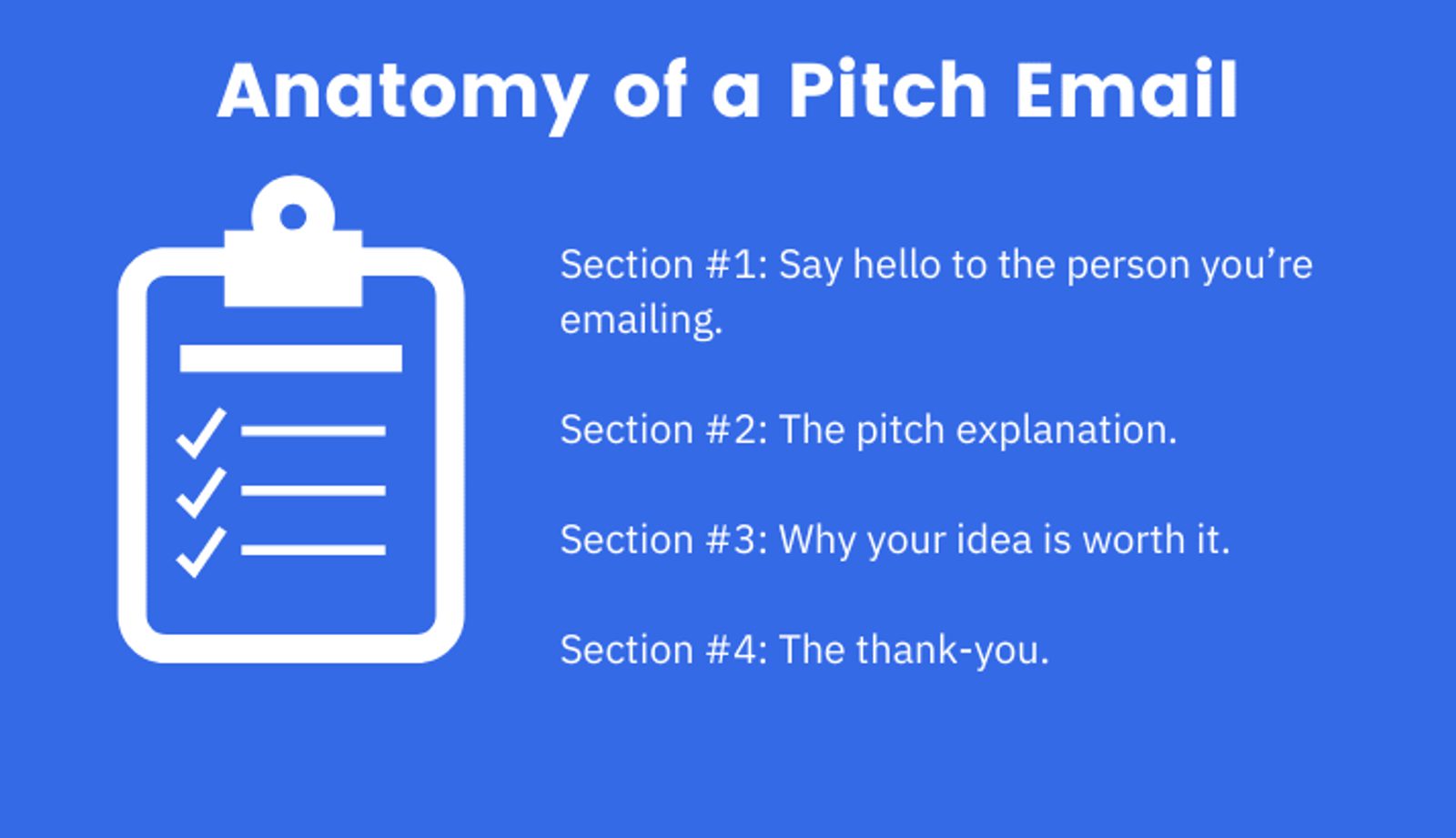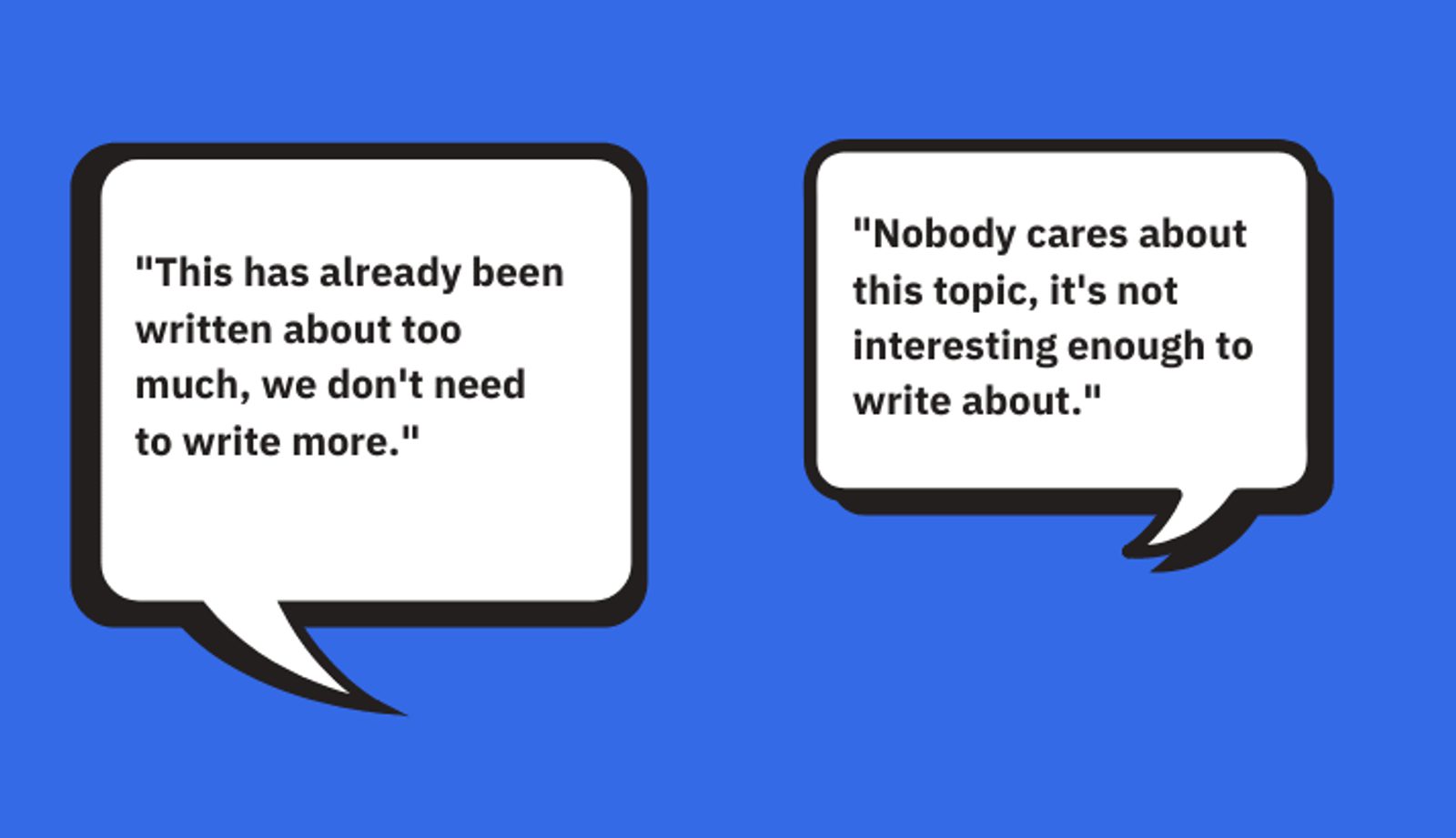Have you ever heard that the human attention span is roughly the same as a goldfish? Studies have shown that the average human attention span matches that of a goldfish – approximately 12 seconds.
Hey, why drag goldfish into this? It’s not even true!
People don’t only spend 12 seconds on everything they see.
Attention depends on the task and number of distractions. People binge Netflix! That alone disproves the 12 seconds thing.
When you’re trying to promote your work, a good pitch can help you get attention from “gatekeepers” – people with access to an audience you want to reach.
But your pitch needs to be good. An editor will ignore you unless you know how to snag their attention.
By far the most common promotion for writing a pitch? An article to a journalist or publication editor. Your pitch can be for 1 of 2 reasons:
- To get them to cover a story you already have
- To see if they're willing to let you write something for them
Whatever you are writing a pitch for you need to make sure it’s good enough to sell someone on an intangible idea. Before you can sell the content you have to sell the concept. And it’s no easy task, but it’s about to get easier.
In this post, you will learn:
- How to deliver your pitch to a publication
- What does a good writing pitch require?
- 5 things you should never do when you create a pitch
How to deliver your pitch to a publication
Email is a common pitch practice, especially to pitch an article.
Much like your pitch, an email needs to be succinct while still sharing relevant info. If your email starts to look like the future paragraph-filled article you want to write, take a second look. No one wants to read a novel in an email.
Here’s the basic outline that a pitch email should follow:

Section #1: Say hello. Try to include something personally relatable, like a shared interest or recent news. Keep your introduction short and sweet.
Section #2: The pitch explanation. Write 3-4 sentences to explain your pitch idea. If it takes you more than 3-4 sentences to do this, you should try to rework it.
Section #3: Why your idea is worth creating. Use this last paragraph to explain why you think it’s a good opportunity for their company. Is this a chance to highlight something their business does well? Does this piece open a revenue-boosting opportunity somehow? The benefits of creating this piece should be personalized to them and should be 2-3 sentences.
Section #4: The thank-you. Thank them for their time and offer schedule a call to discuss the pitch further if they’re interested.
When you write a pitch, you need to hook someone with the first cast of your line. When you send your pitch in an email, your hook can be the email subject line or the opening sentence.
For example, an email with the following subject line got a response in just four minutes:
This post = the entree. Your advice = ...seasoning?
Or if you go for the hook in the opening line, you can start with a specific compliment about the person’s work. Everyone loves a good compliment.
You’re doing a great job reading this post, by the way!
Your pitch email also needs to include written materials prepped and ready for people to refer back to.
Written materials for a pitch include:
- A portfolio of past work – proof that you can create a quality piece
- References from past clients – reassurance that you are a good person to work with
- A completed pitch document – your pitch email is your elevator explanation of the idea, but the pitch document itself goes into more detail. This can also be the completed piece you want a publication to write about
Before you hit Send on your email to the publication getting your pitch, take a look at these 9 extra tips for crafting a pitch email:
1. Read your pitch email out loud. Reading out loud helps you catch and correct things before you hit Send – and practice the whole thing. Don’t skimp over your talking points and assume you remembered to include everything.
2. Write like you’re in an elevator giving an “elevator pitch.” An elevator pitch is typically around 90 seconds, and your pitch email shouldn’t take longer than that to read. The person getting your email should be able to get the main message quickly, then refer to your pitch document for more details.

Tick tock tick tock. Get your idea out there before you run out of floors. (Image Source: Hackernoon)
3. Don't blast. If you pitch an idea to more than one publication, it should be a unique pitch to each one.
4. Know what a publication covers. Part of creating a unique pitch is to sell a publication on how your idea fits in with that they already cover. If you can’t convey that you know what they do, they won’t want to feature your idea.
5. Relate your pitch to a recent article they've written. This is another way to personalize your pitch and better the chances of getting it approved. If you tie in a related article to your pitch, it shows that you’ve thought through how it fits into the publication brand.
6. Provide unique value where possible. What can you offer them that no one else with a pitch can? Something like unique data can set you apart from other pitches.
An example of this comes from an original ecommerce research report that ActiveCampaign’s Nick Bosch compiled.

"Every single pitch email about our ecommerce advertising research study was specific to who got it. For one publication, I focused on the unique value that the report would bring to them. There was heavy talk about the influence of Facebook and Twitter ads in elections.
In my pitch, I specifically highlighted the research from the report that showed the heavy influence of social media ads over consumer shopping and let journalists covering that story know about it. That way, they could either talk about it directly in a new piece or link to the research as a source for other coverage they might have."
7. Tie your news into a major news story. Nothing like a little momentum to strengthen your pitch. If a major news story is already something a publication plans to cover, you can frame your pitch as a way to support it and bolster visibility on both pieces.
8. Engage over social media early and often. A pitch isn’t a one and done action. If you want to keep your pitch (and your name) at the top of their minds, consider sending helpful info related to their stories in post comments or over social.
9. Make it dead simple for them to write the story. Don't make them work for it. An ideal press release tells them everything they need to write the story about your idea.
You are a salesperson, and you’re selling your writing. Not every pitch will pass, but there are ways you can make yours hard to ignore.
What does a good writing pitch require?
Pitch writing isn’t a case of one-size-fits-all – you need to tailor your pitch to the person who hears it. Depending on what project you’re pitching, you need to customize your pitch with certain information.
But still, there are 6 elements that most every official pitch needs to have.
- A hook
- Key message
- Intended audience
- Summary
- Publication timeline
- Contact Info
1. A hook
How do you grab someone's attention with a subject line, or the first sentence of a phone call? That's the first piece of a pitch – and it’s called a hook.
A title tells people what they can expect to read about, but a hook draws people in. It makes the difference between someone wanting to hear more or their eyes glazing over in the first few seconds of reading it.
In your pitch, you aren’t just sending your piece to an editor in hopes that they just like it – you have to create a hook so powerful that they literally feel like they are being pulled to your piece.
How do you do this? Build curiosity. If you hint at something just enough to make people curious, it helps sell them on actually listening.
And guess what – there are 5 ways to build curiosity (a few that you probably didn’t know that you already do!).
In 1994, Carnegie-Mellon professor George Loewenstein published an extraordinary paper with a mundane title: The Psychology of Curiosity. It outlined these 5 methods to build curiosity:
- Ask a curiosity-inducing question: Do you have the courage to earn half a million dollars a year?
- Tell the beginning of a story and intentionally leave it unfinished: this is called the Zeigarnik Effect.
- Do something unexpected or violate expectations: would you expect to see “how to earn half a million dollars,” or “do you have the courage to earn half a million dollars?” Which one do you think you’ll remember?
- Create a perception of “I have information that you don’t: they’ll want to know what it is, and read more to find out.
- Remind them of something they’ve “forgotten”: AKA convincing someone of something they already know
2. Key message
If the person who reads this piece can only take away one thing from it, what should that thing be?
You need to be able to clearly define the key message of your pitch idea. When you create the key message think about what is most important to the person who reads it.
- Do they need an answer to a single question?
- Do they need instructions on how to do something?
- Do they need something that uplifts them or explains a difficult idea?
Find that one most important thing, and spell it out in the key message.
3. Intended audience
When you write your pitch, think about two audiences:
- The audience you present your pitch to
- The audience for your finished piece
Remember, this pitch is your creative vision, but it’s not actually for you. A good rule of thumb to help you keep this in mind is to think of the word “you.”
Tell the story of your pitch with a “you” perspective. For instance, if you write an article pitch for an auto publication about how to improve people’s daily commutes, put yourself in their driver’s seat.
- “What’s the worst part of your daily commute?
- "How completely boring it is to sit in traffic?"
- "Getting stuck in a construction zone you didn’t see coming?”
- "OH CRAP, FLAT TIRE??"
A person at an auto company probably relates to these kinds of problems – and on top of that, knows how their customers can relate too. When you know your audience, you understand how your pitch can help them.
4. Summary
You might see the word summary and think to yourself, “that just means ‘what my pitch is about.’ Duh, of course I’m going to include that.”
Although you’re not wrong, make your summary more specific than just “what this pitch is about.”
A summary is a concise explanation of the most important points of your story. People who review pitches don’t have hours to read multiple pages of explanation – they want to know the main idea and they want to know now.
That means you only need a couple of paragraphs. Focus on your piece’s angle and summarize its key points.
In a writing pitch, you are an idea salesperson. One of the sales skills you need to close the deal is objection handling.
Objection handling is the process of managing a potential client’s concerns.

You can point out the ways your idea is different from another piece about a similar topic or shift the perspective by highlighting a problem that your idea helps solve for a publication’s audience.
People can come up with a million reasons not to do something – like buy into your pitch. Your pitch needs to already sell them on why they should.
Ryan Holiday, author of Trust Me, I'm Lying: Confessions of a Media Manipulator, talks about how to avoid needless pitch rejection and an onslaught of objections from editors.

Ryan’s advice? Listen to Jack London and H.L. Mencken. You can trust Ryan – his books are already published.
Ryan took the advice of Jack London and H.L. Mencken to score his 6-figure book deal – and their advice totally worked. The 3 biggest takeaways from Ryan about structuring a pitch to avoid objection are:
- Keep your pitch short, simple and to the point. Don’t waste their time. Let the work speak for itself.
- Publications have heard too many sob stories to be moved by pity. They just don’t care. So abide by Law of Power #13: “When asking for help, appeal to people’s self-interest, never to their mercy or gratitude.” Self-interest is a lever that will get you somewhere, prostration will not.
- Look at what the magazines you want to be in are currently publishing and see what the market is looking for. Only then should you go to editors with a pitch.
Also – it helps to make the pitch summary into swipeable copy. The publication can steal that copy directly and use it as the backbone of their story.
When you pitch an article, include an outline of section titles with main points to demonstrate the article flow and topics all at once.
5. Publication timeline
When you pitch a publication, you'd typically already have a piece finished – a reporter would be the ones writing any new content about your piece (unless the publication offers you a byline, but that would also happen post-pitch).
The timeline for a pitch to a reporter is more related to factors like:
- Is this news already public? Or does your piece fall under embargoed content (i.e. can only be released on a certain date or if certain conditions are met first)
- What kind of availability can you give the reporter? Is there an executive or other expert you can give them a quote from?
A publication is going to have more of a say in timeline factors like:
- Who has to approve different parts – this is ultimately decided by a publication
- Whether any work has to be done on an article before a publication runs it
Giving an estimated turnaround time helps everyone involved prioritize tasks.
6. Contact info
Don’t get so swept up in perfectly crafting your pitch that you forget to tell someone how they can contact you with an answer or questions.
Conclusion: 5 things you should never do when you create a pitch
Your pitch is the make or break moment for your piece – is it good enough or does it just fall short?
This post has covered a lot of what you need for a killer pitch. BUT it’s not only about what things you do have to do. You also need to think about what not to do when you pitch.
Take this list and go through your pitch. If any of these stand out, head back to the drawing board.
Here’s how not to create a pitch:
1. Use giant walls of text. People only have so much brainpower to process a pitch. Short, clear text is the way to go.
2. Completely ignore the pitch guidelines. If you’re pitching a client, they have their own ideas of what should be included in your pitch. Don’t ignore these. A pitch needs to be tailored to the intended audience, not to you.
3. Copy and paste pitch templates. Templates are wonderful and helpful, but they aren’t meant to be a get-out-of-work free card. Templates are guides to help you create your own unique pitch. If someone repeatedly sees the exact same type of pitch from multiple people who have the same template, it screams incapable.
4. Show uncertainty. If your pitch includes phrases like “I don’t know if this is totally right, but…” remove these immediately. Don’t tell someone your idea is bad before they’ve even heard it. A lack of confidence in your own idea won’t get you the Yes.
5. Generalize the message. An ideal pitch isn’t meant to cover all potential angles of a topic. You should be able to sell one specific message.









